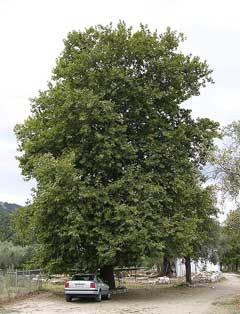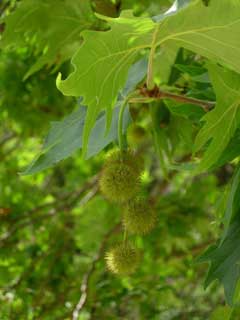 |
|
http://commons.wikimedia.org/wiki/User:Lokal_Profil |
 |
|
Translate this page:
Summary
Physical Characteristics

 Platanus orientalis is a deciduous Tree growing to 30 m (98ft) by 30 m (98ft) at a fast rate.
Platanus orientalis is a deciduous Tree growing to 30 m (98ft) by 30 m (98ft) at a fast rate.
See above for USDA hardiness. It is hardy to UK zone 7. It is in flower in May, and the seeds ripen from October to February. The species is monoecious (individual flowers are either male or female, but both sexes can be found on the same plant).
Suitable for: light (sandy), medium (loamy) and heavy (clay) soils. Suitable pH: mildly acid, neutral and basic (mildly alkaline) soils. It cannot grow in the shade. It prefers moist soil and can tolerate drought. The plant can tolerates strong winds but not maritime exposure.
It can tolerate atmospheric pollution.
UK Hardiness Map
US Hardiness Map
Synonyms
P. vulgaris.
Plant Habitats
Woodland Garden Canopy;
Edible Uses
References More on Edible Uses
Medicinal Uses
Plants For A Future can not take any responsibility for any adverse effects from the use of plants. Always seek advice from a professional before using a plant medicinally.
Astringent Dysentery Ophthalmic Vulnerary
The leaves are astringent and vulnerary[7]. The fresh leaves are bruised and applied to the eyes in the treatment of ophthalmia[240]. A decoction is used to treat dysentery and a cream made from the leaves is used to heal wounds and chilblains[7]. The leaves are harvested in the spring and summer and can be dried for later use[7]. The bark is boiled in vinegar and then used in the treatment of diarrhoea, dysentery, hernias and toothache[240].
References More on Medicinal Uses
The Bookshop: Edible Plant Books
Our Latest books on Perennial Plants For Food Forests and Permaculture Gardens in paperback or digital formats.

Edible Tropical Plants
Food Forest Plants for Hotter Conditions: 250+ Plants For Tropical Food Forests & Permaculture Gardens.
More

Edible Temperate Plants
Plants for Your Food Forest: 500 Plants for Temperate Food Forests & Permaculture Gardens.
More

More Books
PFAF have eight books available in paperback and digital formats. Browse the shop for more information.
Shop Now
Other Uses
Dye Wood
A fabric dye is obtained from the branches and roots[7]. The colour is not given[K]. Wood - tough, difficult to split, not durable. It is not esteemed for carpentry, but has certain advantages in cabinet making[7], it is also used for inlay work and wood pulp[46, 61, 89].
Special Uses
References More on Other Uses
Cultivation details
Requires a sunny position in a deep fertile well-drained soil[188]. A fast growing species, established plants are drought tolerant[200]. Tolerates atmospheric pollution and compacted soils[200]. This species is hardy in most areas of Britain but the trees do not do well in northern parts of the country, requiring hotter summers than are normally experienced there[98]. A very ornamental and very long lived tree[1]. It is immune to 'Plane tree wilt' fungus[11]. Very tolerant of root disturbance, trees up to 5 metres tall can be moved quite easily[200].
References Carbon Farming Information and Carbon Sequestration Information
Temperature Converter
Type a value in the Celsius field to convert the value to Fahrenheit:
Fahrenheit:
The PFAF Bookshop
Plants For A Future have a number of books available in paperback and digital form. Book titles include Edible Plants, Edible Perennials, Edible Trees,Edible Shrubs, Woodland Gardening, and Temperate Food Forest Plants. Our new book is Food Forest Plants For Hotter Conditions (Tropical and Sub-Tropical).
Shop Now
Plant Propagation
Seed - two months cold stratification improves germination[113]. Sow spring in a cold frame in light shade[78, 98]. Home grown seed is often of poor quality and low viability. It is best to harvest the seed in late winter or spring and then sow it immediately in a cold frame[80]. When they are large enough to handle, prick the seedlings out into individual pots and grow them on in the greenhouse for their first winter. Plant them out into their permanent positions in late spring or early summer, after the last expected frosts. Cuttings of mature wood of the current years growth, 20 - 30 cm with a heel, autumn in a cold frame[1]. Easy[200]. Layering of stools in spring or autumn. Takes 12 months[78].
Other Names
If available other names are mentioned here
Native Range
TEMPERATE ASIA: Cyprus, Lebanon, Syria, Turkey EUROPE: Albania, Bulgaria, Greece (incl. Crete), Croatia, Italy (incl. Sicily), North Macedonia
Weed Potential
Right plant wrong place. We are currently updating this section.
Please note that a plant may be invasive in one area but may not in your area so it's worth checking.
Conservation Status
IUCN Red List of Threatened Plants Status :

Growth: S = slow M = medium F = fast. Soil: L = light (sandy) M = medium H = heavy (clay). pH: A = acid N = neutral B = basic (alkaline). Shade: F = full shade S = semi-shade N = no shade. Moisture: D = dry M = Moist We = wet Wa = water.
Now available:
Food Forest Plants for Mediterranean Conditions
350+ Perennial Plants For Mediterranean and Drier Food Forests and Permaculture Gardens.
[Paperback and eBook]
This is the third in Plants For A Future's series of plant guides for food forests tailored to
specific climate zones. Following volumes on temperate and tropical ecosystems, this book focuses
on species suited to Mediterranean conditions—regions with hot, dry summers and cool, wet winters,
often facing the added challenge of climate change.
Read More
Expert comment
Author
L.
Botanical References
1189200
Links / References
For a list of references used on this page please go here
Readers comment